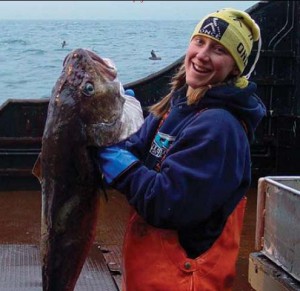
Pacific cod (Gadus macrocephalus) is a species that supports large and successful fisheries in Alaska, but has declined precipitously in Puget Sound. Our previous genetic data demonstrated very clear differentiation of the Puget Sound population (Cunningham et al. 2009), originating from long isolation predating the last glacial maximum (Canino et al. 2010). Primarily based on these results, Pacific cod in Puget Sound was listed as a NOAA Species of Concern in 2011. Along the coast, our results showed an isolation-by-distance pattern that suggested surprisingly short dispersal distances for a species with a three months larval period (Cunningham et al. 2009). This work motivated follow-up studies by Ingrid Spies (NOAA) in Alaska, which found similar results and in part prompted the separation of the Aleutian Island and Bering Sea management areas.
Subsequent work with next-generation sequencing (specifically RAD sequencing) allowed us to expand on these results by employing many thousands of markers. This increased statistical power allowed us to confirm the isolation-by-distance pattern with a different marker set, but also improve our ability to assign individual cod to their population and location of origin (Drinan et al. 2018). We also identified a single gene (zona pellucida 3, a gamete recognition gene) that showed extremely high differentiation between Gulf of Alaska and Eastern Bering Sea and Aleutian Island cod (Spies et al. 2021). In Korea, on the other side of the Pacific, we could identify individual dispersers from isolated populations and show that dispersal occurred primarily from the edge to the center of the distribution (Fisher et al. 2020).
Based on these studies, we are currently investigating the importance of peripheral populations for climate adaptation and productivity of Gulf of Alaska cod. The cod fishery in the Gulf of Alaska collapsed after a heat wave caused a precipitous population decline, and in 2020 the federal cod fishery was closed entirely. The extent to which this collapse caused a reduction in genetic diversity and to which genetic diversity can be replenished by immigration from potentially warm adapted southern populations is central to the prediction of future changes in cod distribution and productivity. This project is a collaboration of Dr Danielle Schmidt with Ben Laurel and Ingrid Spies (NOAA), Trond Kristiansen (Farallon Institute), Kat Meyers and Jennifer Blaine (WDFW), and Robyn Forrest and Dana Haggarty (DFO).